Health: Keeping Healthy in a Changing Climate
9 minute read
Updated on: 08 May 2021
Our health is closely connected to our planet’s health . This means that if our planet gets sick, so do we
. For example, higher atmospheric CO₂ has been linked to lower levels of protein, iron and zinc in the crops we grow
. This results in lower quality food and makes it difficult for people to get the right nutrition
. In this chapter we’ll explore why the climate crisis is also a health crisis
, and how we might adapt our healthcare to meet the threats we face.
What happens if we don’t adapt?

Health and Climate Change
1. Direct Effects
As the Earth gets hotter, the risk of heat-related illness increases because your heart, lungs and kidneys have to work harder to maintain your body temperature
. An extra 125 million more people were exposed to heat waves between 2000-2016
, and scientists predict that ‘mega’ heat waves (ie. at least 6 days with temps over 30ºC) in Europe will become 5 to 10 times more frequent by 2050
. On the flip side, these increased temperatures could result in fewer cold-related deaths
.
Some diseases, like cholera, dengue and malaria, are ‘climate-sensitive’. This means that the spread of disease depends on factors like temperature and rainfall . Therefore, if the climate changes, it has an impact on where and who these diseases affect
.
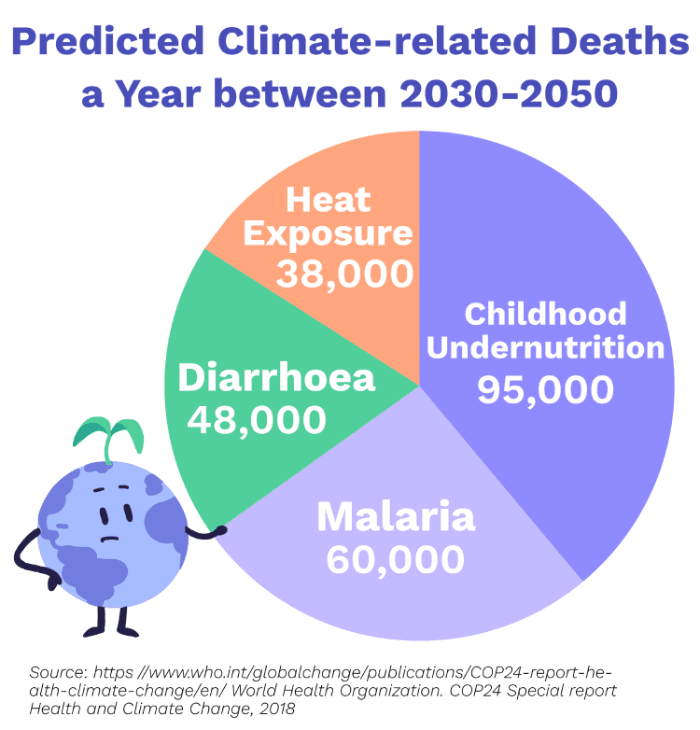
Health impacts of Climate Change
2. Indirect Effects
Climate change can also indirectly affect health in ways we might not immediately think of. Take floods, which help the spread of certain diseases , or pollution from forest fires, thought to cause roughly 340,000 early deaths each year
. We can also expect higher levels of conflict between and within countries
, and greater numbers of environmental refugees who are unable to get basic healthcare
.
Combined, these effects of climate change on health are predicted to come at a huge cost to society through illness and death .
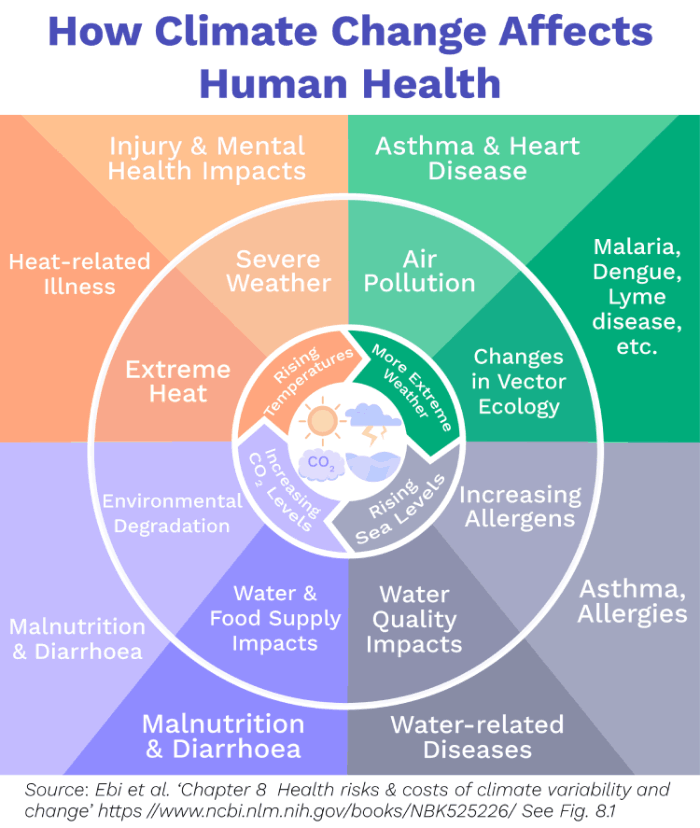
Health Impacts of Climate Change
Those at highest risk are the old, the very young , and people living in countries where it is already a struggle to provide decent healthcare
. Climate change also puts the health of future generations at risk
. If we are to avoid the worst of these health risks, we need to prepare and adapt as soon as possible
.
Climate-smart healthcare
Cutting carbon emissions has a massive potential to prevent unnecessary illness and death in the future . This is important mitigation work but we still need to adapt, and for that we need a plan
. As of 2018, only 48 countries had formal health adaptation plans, but even then the majority were struggling to put these plans into action
.
For starters, we need to make sure everyone has basic access to healthcare by building hospitals and clinics where they are most needed
. For example, in areas vulnerable to flooding, like Bangladesh, some communities now use ‘floating hospitals’
. We can also adapt by recruiting more nurses and doctors and providing them with training on the health risks of climate change and how to treat them
.
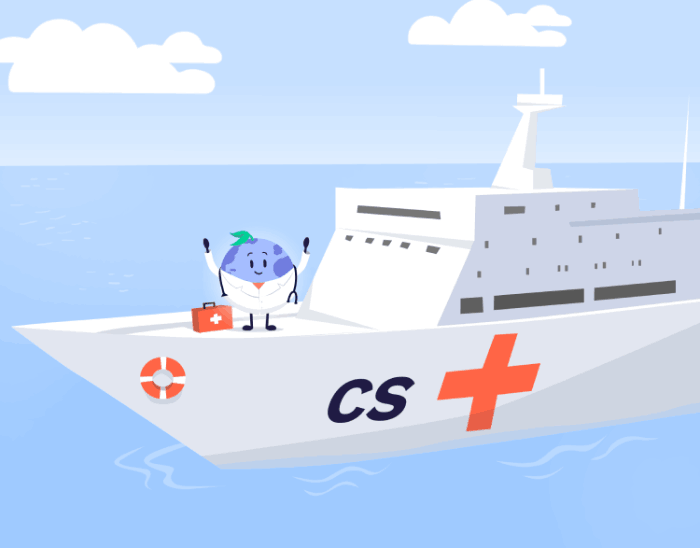
Floating Hospitals
Recently, people have been designing ‘greener’ hospitals that make greater use of environmentally friendly building design, renewable energy supplies and telemedicine (i.e. providing remote care using communication technologies
), all of which can lower costs and save lives
. This type of adaptation is said to create ‘co-benefits’ (ie. solutions which have multiple advantages)
.
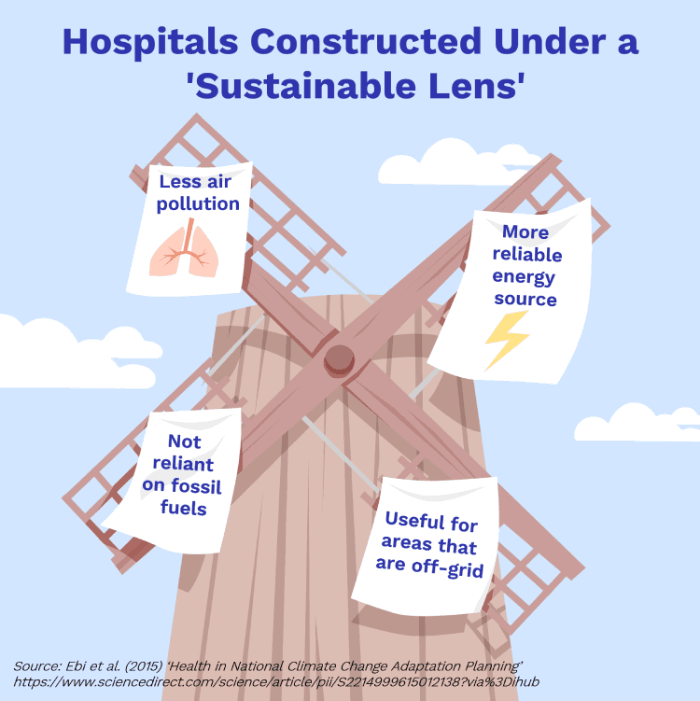
Green Hospitals
Adaptation outside the health sector
However, it is not just the health sector that will need to adapt . If we want to reduce health risks associated with climate change, it is going to require effort from governments and industries too
. This means investing in better sanitation
, climate monitoring
, education
and farming
. Governments can also take the lead by setting safe working standards to protect workers from heat exposure and other impacts of climate change
.
The need for health-related adaptation has increased the demand for infrastructure that is both good for the planet and our health. For example, increased plant life in urban areas has been shown to reduce heat-related death rates by 40-90% and is also linked to reduced stress levels
and a stronger sense of community
.
In fact, upgrading our infrastructure could play a big role in keeping us healthy . For example, we can limit the spread of disease during flooding
by updating our coastal defences and sewage systems to deal with excess stormwater
.
By looking at the big picture and adapting other areas of society, we can reduce pressures on our healthcare systems .
Technology, Monitoring and Mapping
If we want to keep people healthy in a changing climate, we need to establish better ways of monitoring climate-sensitive diseases . This is where Early Warning Systems (‘EWS’) come in handy. EWS use historic data to predict future hazards like floods and heatwaves, allowing us to inform the populations at risk ahead of time
. From there, EWS help us plan a response so that we can better reduce the effects on people’s health
, such as opening cooling stations that provide water, shade and air conditioning
. Luckily, EWS work really well. In the USA, using an EWS resulted in 50% fewer deaths when comparing two similar heatwaves
.
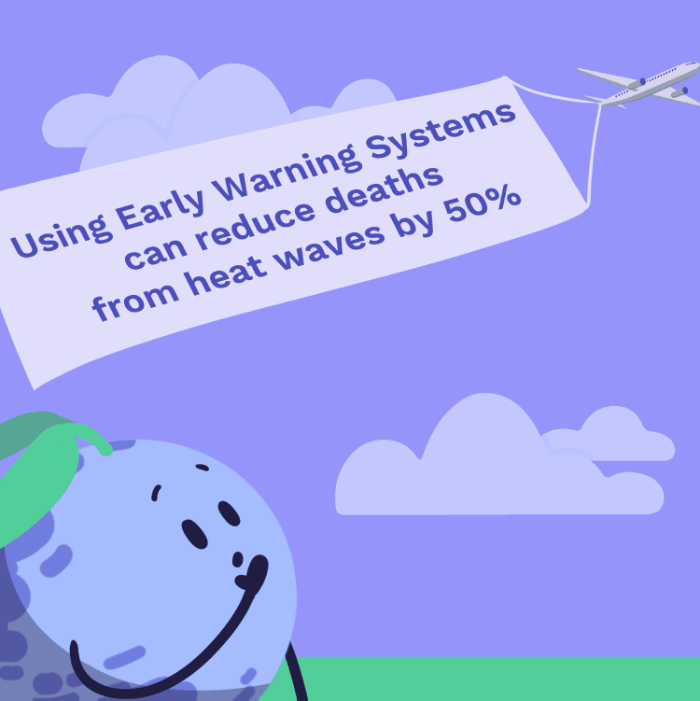
Early Warning Systems for heat waves
Aside from heat waves, EWS are also a brilliant tool for tracking climate-sensitive diseases . This will prove particularly useful for diseases like malaria, which are typically associated with hotter areas nearer the equator but are predicted to spread to new areas as a result of climate change
. To make sure EWS are effective, we need accurate data from scientists who study weather and disease transmission
.
Public Health and Communications
An important part of monitoring climate-sensitive diseases and other health threats is making sure the wider public are prepared . This is where education and communication complete the puzzle
, allowing us to coordinate responses between and within countries
. Through public health education, we can help people understand what to do and where to go (or not go!) in the event of a natural disaster or other climate-related health threat
.
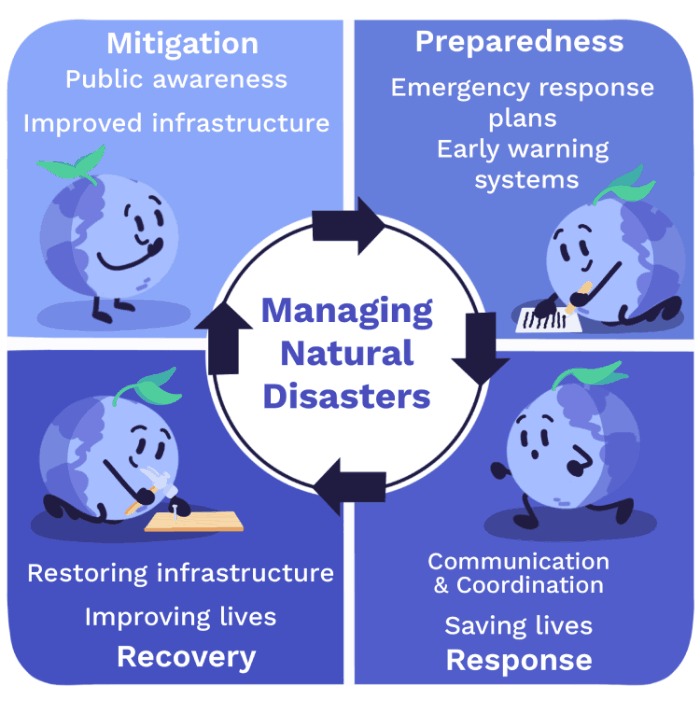
Managing natural disasters; preparation and execution
What about me?
On a personal level, a changing climate could mean making small changes in our day-to-day lives in order to keep ourselves and those around us healthy. At the extreme end, this could involve planning for emergency situations and responding to Early Warning Systems when necessary . On a less serious note, when it comes to heatwaves, the odd siesta in the shade could be a popular, and scientifically approved, option
!

How to keep cool
Conclusion
We now know that climate change means society is going to experience changing healthcare demands. We’ve also taken a look at the ways we can adapt to these threats through Early Warning Systems , raising public awareness
, stronger community responses
, and by investing in our healthcare systems
. Although these require time, effort, and money, the rewards are likely to outweigh the costs, and reduce potential health risks, in the long run
. By using solutions like greener healthcare, we can even give nature a helping hand along the way too
. At an individual level, we can make a start by helping others understand that long-term good health depends on a healthy planet too
.